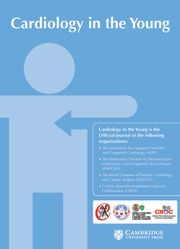No CrossRef data available.
Article contents
Motor proficiency in school-aged children with CHD
Published online by Cambridge University Press: 19 November 2024
Abstract
To evaluate the motor proficiency, identify risk factors for abnormal motor scores, and examine the relationship between motor proficiency and health-related quality of life in school-aged patients with CHD.
Patients ≥ 4 years old referred to the cardiac neurodevelopmental program between June 2017 and April 2020 were included. Motor skills were evaluated by therapist-administered Bruininks-Oseretsky Test of Motor Proficiency Second-Edition Short Form and parent-reported Adaptive Behavior Assessment System and Patient-Reported Outcomes Measurement Inventory System Physical Functioning questionnaires. Neuropsychological status and health-related quality of life were assessed using a battery of validated questionnaires. Demographic, clinical, and educational variables were collected from electronic medical records. General linear modelling was used for multivariable analysis.
The median motor proficiency score was the 10th percentile, and the cohort (n = 272; mean age: 9.1 years) scored well below normative values on all administered neuropsychological questionnaires. In the final multivariable model, worse motor proficiency score was associated with family income, presence of a genetic syndrome, developmental delay recognised in infancy, abnormal neuroimaging, history of heart transplant, and executive dysfunction, and presence of an individualised education plan (p < 0.03 for all predictors). Worse motor proficiency correlated with reduced health-related quality of life. Parent-reported adaptive behaviour (p < 0.001) and physical functioning (p < 0.001) had a strong association with motor proficiency scores.
This study highlights the need for continued motor screening for school-aged patients with CHD. Clinical factors, neuropsychological screening results, and health-related quality of life were associated with worse motor proficiency.
- Type
- Original Article
- Information
- Copyright
- © The Author(s), 2024. Published by Cambridge University Press



